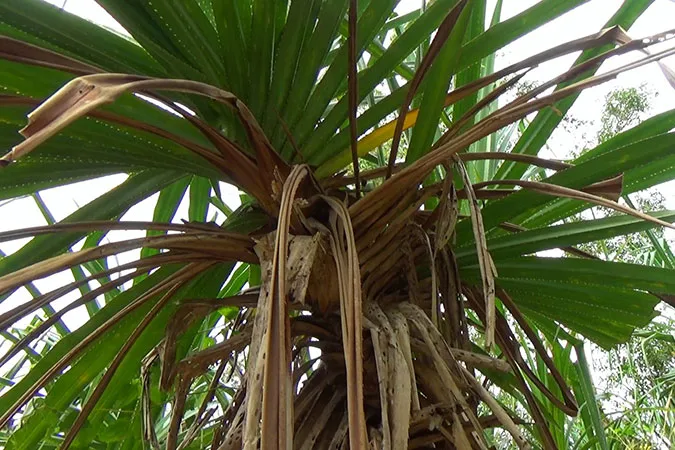Pandan duri or pandan tikar or thatch screwpine (Pandanus tectorius) are species of tree-like plants in Pandanaceae, dioesis, are highly variable in shape and character, have many varieties and some are cultivated for different purposes.
P. tectorius is a wide-branched shrub, 3-7 m high and sometimes has many trunks. Roots and hanging roots have a large size and striking. Ribbon-shaped leaves, 70-250x3-9 cm, stiff, bluish green and waxy, parallel with bones, spines on the edges and underside of the leaf bone.
The leaves gather tightly at the end of a branch in 3 rows arranged in a spiral with the base hugging the stem to leave a ring-shaped mark. Hanging male flowers, 25-60 cm long, 10-20 side branches, veiled in a white-yellow sheath that smells good. The female flowers are aloof, rounded hump shaped and 5 cm in diameter.
Compound fruit has many variations for shape, size and color. Shapes ranging from ovoid, ellipsoid, almost round and full ball. Length 8-30x4-20 cm on the center line. Phalanges are ovoid inverted to oblong, 2.5-11x1.5-6.7 cm and the skin is green, yellow, orange and red when ripe.
Mesocarp is white, fiber and filled with air at the tip, yellow to orange or red-orange at the base. Ovoid seeds, pushing or oval and 6-20 millimeters long. Often grow in sandy and rocky areas at an altitude of 0-610 m, rainfall 1500-4000 mm/year, adapt in various of soil including quartz sand, coral sand, peat, limestone and basalt.
Pandan duri is tolerant of high salt content and continuous gusts of wind, like the soil with a pH of 6-10. It grows very well in full sun, but can also grow well with a shade of 30-50%.
Different varieties produce different benefits. Generally P. tectorius is cultivated for soft and strong leaves to be woven, others for male flowers that smell nice to scent the room, clothes or perfume. Another variety for delicious fruit.
Kingdom: Plantae
Phylum: Tracheophyta
Subphylum: Angiospermae
Class: Liliopsida
Order: Pandanales
Family: Pandanaceae
Genus: Pandanus
Species: Pandanus tectorius
Varieties: Pandanus tectorius var. tectorius
P. tectorius is a wide-branched shrub, 3-7 m high and sometimes has many trunks. Roots and hanging roots have a large size and striking. Ribbon-shaped leaves, 70-250x3-9 cm, stiff, bluish green and waxy, parallel with bones, spines on the edges and underside of the leaf bone.
The leaves gather tightly at the end of a branch in 3 rows arranged in a spiral with the base hugging the stem to leave a ring-shaped mark. Hanging male flowers, 25-60 cm long, 10-20 side branches, veiled in a white-yellow sheath that smells good. The female flowers are aloof, rounded hump shaped and 5 cm in diameter.
Compound fruit has many variations for shape, size and color. Shapes ranging from ovoid, ellipsoid, almost round and full ball. Length 8-30x4-20 cm on the center line. Phalanges are ovoid inverted to oblong, 2.5-11x1.5-6.7 cm and the skin is green, yellow, orange and red when ripe.
Mesocarp is white, fiber and filled with air at the tip, yellow to orange or red-orange at the base. Ovoid seeds, pushing or oval and 6-20 millimeters long. Often grow in sandy and rocky areas at an altitude of 0-610 m, rainfall 1500-4000 mm/year, adapt in various of soil including quartz sand, coral sand, peat, limestone and basalt.
Pandan duri is tolerant of high salt content and continuous gusts of wind, like the soil with a pH of 6-10. It grows very well in full sun, but can also grow well with a shade of 30-50%.
Different varieties produce different benefits. Generally P. tectorius is cultivated for soft and strong leaves to be woven, others for male flowers that smell nice to scent the room, clothes or perfume. Another variety for delicious fruit.
Kingdom: Plantae
Phylum: Tracheophyta
Subphylum: Angiospermae
Class: Liliopsida
Order: Pandanales
Family: Pandanaceae
Genus: Pandanus
Species: Pandanus tectorius
Varieties: Pandanus tectorius var. tectorius
